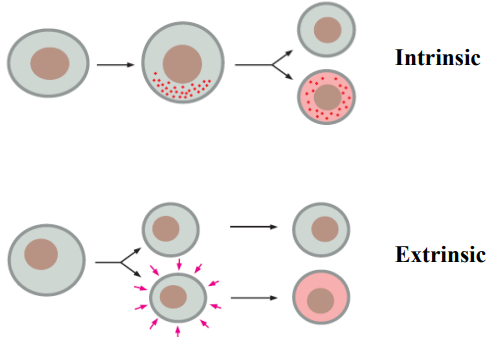15. Intro to developmental genetics
1/12
There's no tags or description
Looks like no tags are added yet.
Name | Mastery | Learn | Test | Matching | Spaced |
|---|
No study sessions yet.
13 Terms
What is the difference between intrinsic and extrinsic asymmetric divisions?
What is a morphogen?
Does a morphogen need to be distributed as a gradient within a system?
Considering a system where a transcription factor is a morphogen. How might this morphogen gradient be decoded?
What makes the Drospohila larvae a good developmental model?
Pattern Formation
What is apical-basal polarity?
What is dorsal-ventral polarity?
What is bilateral symmetry?
What is radial symmetry?
Apical-basal polarity = a fundamental property of the epithelium, defined by the apical membrane facing the outside surface of the body, or the lumen of internal cavities, and the basolateral membrane oriented away from the lumen.
Dorsal-ventral polarity = Dorsal-ventral polarity is established by the gradient of a transcription factor called Dorsal (dorsal-ventral = back to belly).
Bilateral symmetry = the right and left sides are mirror images of one another (humans are considered to have bilateral symmetry).
Radial symmetry = can be divided into 2 matching halves by many different lines, which all intersect one another at a single point in the center (like a flower).
Name the 4 processes conducted by cells involved in development.
Cell proliferation
Cell specialisation - cell fate determination
Cell interaction
Cell movement

Asymmetric cell division
What is asymmetric division?
What cell process does asymmetric division enable?
When does asymmetric division usually occur and if it doesn’t take place then what cells could it involve?
What is intrinsic asymmetric division?
What is extrinsic asymmetric division?
An asymmetric cell division produces two daughter cells with different cellular fates.
Cell specialisation - cell fate determination.
Typically found very early in development - when it’s not early it can be associated things like stem cells and a stem cell dividing to give rise to a progenitor.
Intrinsic asymmetric division = there is an intrinsic factor within the cell prior to division that is going to dictate the fate of the progeny cells (e.g metabolite, signalling molecule, transcription factor, e.t.c), the intrincsic factor is polarised in the cell prior to cell division. The cell division plane occurs to ensure that the intrinsic factor is inherited differentially by the 2 progeny cells. Resulting in deviation of the cell fates between the cells.
Extrinsic asymmetric division = extrinsic factors impact upon the cells after cell division (e.g cell communication, components secreted by neighbouring cells) influencing the differential fate of the 2 progeny cells.

Lateral inhibiton
A type of cell–cell interaction whereby a cell that adopts a particular fate inhibits its immediate neighbours from doing likewise.
A component within a cell that can inhibit the production of itself within a neighbouring cell.
The component might not directly inhibit, it may result in a signalling pathway that signals to other cells to inhibit the production of itself in the cell.
If one of the cells has a transient bias in how much of the component it has present within it, lateral inhibition will amplify that bias. The cell with more of the component will start to dominate the other cell and eventually all of the component will be concentrated within that cell, generating bistability (2 cells interact to regulate each other’s fates, it’s an all-or-none situation - you either become something or you don’t - it’s an on/off switch)
Assembling the pattern increasing complexity
cell-to-cell signalling
Assembling the pattern - morphopen greadients act over greater distance
A morphogen is a signalling molecule that acts directly on cells to produce specific cellular responses depending on its local concentration.
Assembling the pattern - Morphogen distribution, inhibitor distribution, morphogen activity
Assembling the pattern - transcription factor binding sites affinity
morphogenic transcription factor
Assembling the pattern - morphogen gradient
Gene regulation can be complex
morphogenic transcription factor - high, medium and low affinity
repressor transcription factor - high and low affinity
The genetics of drosophila melanogaster development
Drosophila development